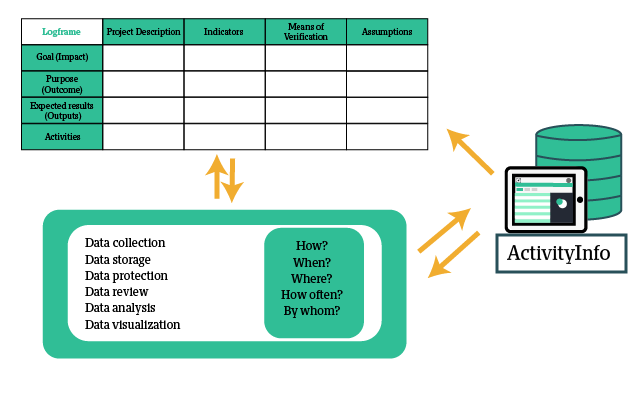Logical Frameworks, Information Management Systems and ActivityInfo
What is a Logical Framework (LogFrame)?
The Logical Framework (LogFrame), a central part of a humanitarian or a development program, is the tool that allows several actors within a program to collaborate based on a common reference. Project Managers, Monitoring and Evaluation Officers and Donors use the LogFrame as a common reference for the progress of the program.
A LogFrame covers:
- the overall goal of the project; the summary of what the project aims to achieve
- the more specific objectives; the purpose of the project
- the expected results; the output of the project
- the actual activities
- the indicators needed for each level of analysis
- the means of verification for each indicator
- the assumptions/external conditions needed for each level to be fulfilled
By looking at the vertical axis of a Logical Framework, one should be able to understand the cause and effect relationships of:
- the activities to the results
- the results to the specific objectives
- the specific objectives to the overall goal
At the same time, by looking at the horizontal axis of the LogFrame, one should be able to have a clear view of:
- the indicators that need to be tracked for each level of analysis
- the means through which the indicators can be validated
- the external conditions that must be present in order for the overall goal to be achieved

The LogFrame is a very useful framework to work with as long as:
- It has been designed based on a Problem Analysis that has highlighted the needs for intervention and has based the overall goal and the specific objective(s) on these.
- There has been careful planning and clear explanation for each level of analysis.
- The indicators set are Objectively Verifiable and SMART.
In addition, having many indicators for each Specific Objective is not advisable as this can make the Monitoring and Evaluation process at a later stage harder. Also it is important to remember that although the Indicators are defined during the programming stage, they can and most of the times should be altered during the implementation phase as during this phase it becomes clearer what works and what doesn't.
Last but not least, high level indicators should be as carefully defined as low level indicators taking into consideration the relevance, accessibility and reliability of the external sources of information that will be used.
All in all, the LogFrame is a very flexible tool. In order for it to be efficient and reflect the real progress of the program, it has to be iterative and based on real-time numbers.
What is an Information Management System?
The Information Management System is the system where all the information related to the LogFrame takes form. It is the system that allows you to operationalize the plan with which the LogFrame numbers will be gathered, monitored, evaluated and reported. Although it is separate from the LogFrame, it is what supports the LogFrame.
More specifically, an Information Management System may begin with your Monitoring and Evaluation Plan or with your Measurement Plan. It includes every action or plan with which you define how, when (or how often), where and by whom:
- data will be collected
- data will be stored
- data will be protected
- data will be reviewed and cleaned
- data will be analysed
- data will be reported/visualized
Ultimately, following this process, the data will produce the numbers needed for the LogFrame.
Where does ActivityInfo fit into this?
ActivityInfo is a software for building an Information System and can be used by Programme Managers, Monitoring and Evaluation officers, Information Management Officers or anybody else responsible either for the LogFrame Goal or for the lower level indicators.
It is not a platform to help you design or write a LogFrame but it has been created to support the LogFrame and help you operationalise it.
It can also be an alternative - quicker and more cost-effective - solution comparing to building your own information system or hiring someone to build a system for you.
More specifically, ActivityInfo allows you to:
- Define and execute data collection
- Store collected data safely
- Analyse your data and compute indicators
- Share continuous reports

By using the software to collect and store data you can have an overview of the data collected in real-time and take informed decisions on any needed changes for your LogFrame.
Also you can take a better look at the details of specific cases and analyse the data needed to get to the higher level indicators you need.
Finally, you can have confidence in the data you report to other partners or to donors since your reports are based on what has been collected in a centralized system under your control.
If you are interested in a more thorough walkthrough on building a complete data collection system for Monitoring and Evaluation activities, please consider taking the online, free self-paced course "Mastering the basics of information management with ActivityInfo".